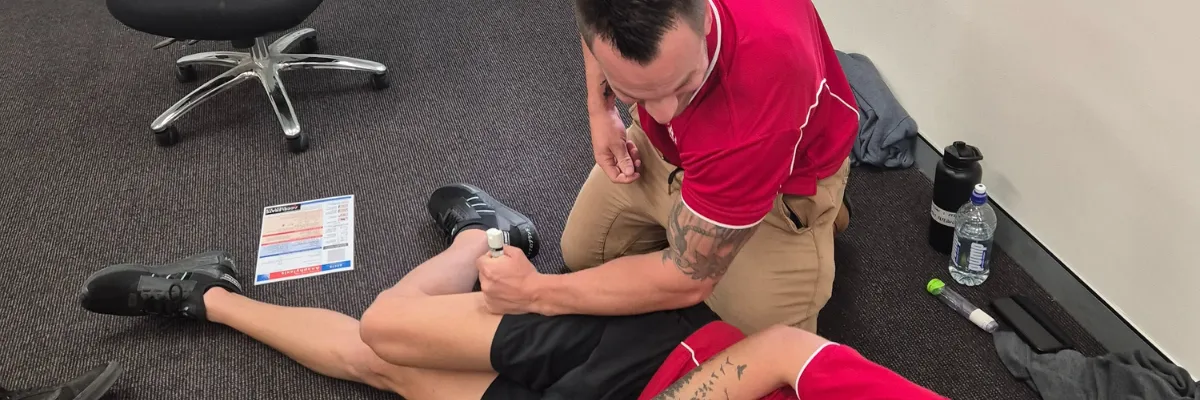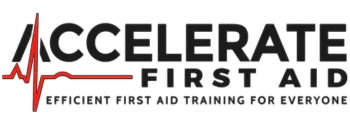
Asthma First Aid Course for Parents: Essential Emergency Skills Every Brisbane Parent NeedsPost
Picture this: You're at your daughter's soccer game on a Saturday morning at Kedron Park. The Brisbane humidity is already building, and suddenly you hear that familiar wheeze from the sideline. Your heart drops as you realize your child is struggling to breathe, and panic starts setting in. What do you do? How do you help? Will you know the right steps to take?
Every 8 minutes, an Australian child visits the emergency department due to asthma - that's over 65,000 visits annually. For Brisbane parents, knowing how to respond when your child can't breathe isn't just helpful knowledge - it's potentially life-saving. And here's the thing that keeps many parents up at night: most of us feel completely unprepared when our kids face breathing emergencies.
I've seen it countless times in our training sessions. Parents arrive feeling anxious, worried they won't know what to do if their child has an asthma attack. They're carrying this heavy burden of responsibility, wondering if they're doing enough to keep their kids safe. Sound familiar?
The good news? You don't have to feel helpless anymore. With proper asthma first aid training, you'll gain the confidence and skills to respond effectively during those scary moments when every second counts.
This guide will show you exactly what every Brisbane parent needs to know about asthma emergencies, from recognizing the warning signs to providing immediate care while waiting for paramedics. You'll discover the essential skills taught in professional asthma first aid courses, how to choose the right training provider in Brisbane, and practical steps to keep your family prepared for asthma emergencies.
Understanding Childhood Asthma: What Every Parent Must Know
Here's what many Brisbane parents don't realize: childhood asthma isn't just about occasional wheezing. It's a serious condition that affects one in nine Australian children, and our subtropical climate makes Brisbane kids particularly vulnerable. The combination of high humidity, seasonal pollen, and year-round allergens creates a perfect storm for asthma triggers.
Warning Signs That Require Immediate Action
Most parents think they know what an asthma attack looks like, but the reality is much more subtle. Yes, wheezing is a classic sign, but it's not always present. Sometimes the most dangerous attacks are the quiet ones.
Watch for these warning signs that mean you need to act fast:
Difficulty speaking in full sentences - If your child can only say a few words at a time, their breathing is severely compromised
Pulling in of the skin around the ribs or neck - This means they're working extra hard to breathe
Pale or blue lips and fingernails - This is a medical emergency requiring immediate 000 call
Sitting hunched forward, gripping something for support - Kids instinctively do this to open their airways
Restlessness or inability to lie down - Severe breathing difficulty makes lying flat impossible
The scary truth? Many parents wait too long to act because they're hoping it will get better on its own. But when your child is struggling to breathe, every minute counts.
Common Asthma Triggers in Brisbane's Climate
Living in Brisbane means dealing with some unique asthma challenges. Our climate creates conditions that can trigger attacks throughout the year, not just during traditional "allergy season."
Humidity and Heat: Brisbane's subtropical climate means humidity levels often exceed 70%, especially during summer months. This creates perfect conditions for dust mites and mold growth - two major asthma triggers that thrive in our homes year-round.
Pollen Patterns: Unlike southern cities, Brisbane has multiple pollen seasons. Grass pollen peaks from October to December, tree pollen from August to October, and weed pollen can be present almost year-round. The jacaranda trees that make our city beautiful? They're also major triggers for many kids.
Sudden Weather Changes: Brisbane's famous afternoon storms can trigger asthma attacks. The rapid drop in barometric pressure, combined with increased humidity and stirred-up allergens, creates a triple threat for sensitive airways.
When to Emergency Hotline vs. Managing at Home
Call Emergency Hotline immediately if your child:
Cannot speak in full sentences
Has blue lips or fingernails
Is using their reliever inhaler more than every 4 hours
Appears drowsy or confused
Is sitting upright and cannot lie down
You can likely manage at home if:
Your child can speak normally but has mild wheezing
Symptoms improve after using their reliever inhaler
They can lie down comfortably
Color remains normal

Essential Asthma First Aid Skills for Parents
Now that you understand the warning signs, let's explore the specific skills that could save your child's life. This is where proper training makes all the difference - knowing these techniques isn't enough, you need to practice them until they become second nature.
Step-by-Step Emergency Response Protocol
When your child is having an asthma attack, every action you take matters. Here's the protocol that medical professionals use, adapted for parents:
Step 1: Stay Calm and Assess I know this sounds impossible when your child can't breathe, but your calm energy will help them stay calmer too. Panic makes breathing even harder. Take a deep breath yourself, then quickly assess their symptoms.
Step 2: Position Your Child Properly
Help them sit upright, leaning slightly forward
Never lay them down flat - this makes breathing much harder
Support them with pillows or let them lean on a table
Loosen any tight clothing around their neck or chest
Step 3: Give Medication Immediately
Get their reliever inhaler (usually blue)
Shake the inhaler 5-6 times
Help them take slow, deep breaths with the medication
Give 4 puffs, waiting 30 seconds between each puff
Step 4: Monitor and Reassess
Wait 4 minutes, then check if symptoms are improving
If no improvement, give another 4 puffs
Keep talking to your child in a calm, reassuring voice
Step 5: Seek Medical Help
If symptoms don't improve after the second round of medication, call 000
Even if symptoms do improve, contact your doctor for follow-up
Proper Inhaler Technique for Children
Here's something that shocks most parents: up to 90% of people use inhalers incorrectly. Even adults who've been using them for years often get it wrong. With children, proper technique becomes even more important.
For Younger Children (Under 6):
Always use a spacer device - this is non-negotiable for young kids
Put the inhaler in one end of the spacer
Place the spacer mask firmly over their nose and mouth
Press the inhaler once, then have them breathe normally for 5-6 breaths
For Older Children (6+):
They can use the inhaler directly, but a spacer is still better
Shake the inhaler first
Have them breathe out fully
Put lips around the inhaler mouthpiece
Start breathing in slowly and deeply, then press the inhaler
Continue breathing in slowly for 3-5 seconds
Hold breath for 10 seconds if possible
Practice this technique with your child when they're well. During an emergency is not the time to be teaching proper inhaler technique.

Professional Asthma First Aid Training in Brisbane
Reading about these techniques is one thing, but actually being able to perform them confidently when your child can't breathe? That's where professional training becomes invaluable. I've seen the difference it makes - parents who've done hands-on training respond faster, stay calmer, and make better decisions during real emergencies.
Course Content and Certification Requirements
When you're looking for an asthma first aid course for parents in Brisbane, you want comprehensive training that actually prepares you for real-world situations. The gold standard is the 22300VIC course - Provide First Aid Management of Anaphylaxis and 22556VIC - Provide First Aid for Asthma Management.
What You'll Learn in Professional Training:
Hands-On Inhaler Practice: You'll practice with actual training devices, not just watch demonstrations. This includes learning to use different types of inhalers and spacers, because not all devices work the same way.
Real Emergency Scenarios: Good training providers use realistic scenarios based on actual Brisbane emergency situations. You might practice responding to an attack at a Southbank playground or during a school sports day.
Age-Specific Techniques: Managing a 3-year-old's asthma attack is completely different from helping a 12-year-old. Professional courses teach you how to adapt your approach based on your child's age and development level.
Integration with Emergency Services: You'll learn how to communicate effectively with 000 operators and paramedics. What information do they need? How can you help them help your child faster?
Finding Qualified Training Providers
Not all training providers are created equal. Here's what to look for when choosing a provider in Brisbane:
Registered Training Organization (RTO) Status: Any legitimate training provider must be registered with ASQA (Australian Skills Quality Authority). Check their RTO number and verify it on the government website.
Instructor Qualifications: Your instructor should hold current TAE40116 - Training and Assessment qualifications plus relevant first aid instructor certifications.
Local Experience: Brisbane-specific knowledge matters. Your instructor should understand our climate challenges, common local triggers, and how our emergency services operate.
Creating an Asthma-Safe Home Environment
Professional training gives you the skills to respond to emergencies, but wouldn't it be better to prevent them in the first place? Creating an asthma-safe home environment is about building a comprehensive support system that protects your child 24/7.
Emergency Action Plans for Families
Every family dealing with asthma needs a written action plan - not stored on your phone, but printed, laminated, and posted where everyone can see it.
Your Family Asthma Action Plan Should Include:
Child's information and emergency contacts
Daily management instructions
Emergency response steps
When to call 000
What information to give emergency services
Place copies in your kitchen, your child's bedroom, the car, and give copies to school, grandparents, and regular babysitters.

Take Action Today
You now have the knowledge foundation every Brisbane parent needs about asthma emergencies. You understand the warning signs, know the essential response techniques, and recognize the value of professional training. You also understand how to create a home environment that supports your child's health and safety.
But knowledge alone isn't enough. The families who succeed in managing childhood asthma are the ones who take action - who invest in proper training, create comprehensive action plans, and build support networks before emergencies happen.
Your child's safety is too important to leave to chance. The next asthma attack will happen whether you're prepared or not. The question is: will you be ready to respond with confidence, or will you be another parent standing helplessly while your child struggles to breathe?
Don't wait for an emergency to realize you need better skills. Book your asthma first aid course for parents today, and give yourself the peace of mind that comes from knowing you're truly prepared to protect your child.
Because when your child can't breathe, every second of your response matters. Make sure you're ready to make those seconds count.
The next asthma emergency in your family will happen whether you're prepared or not.
The only question is: Will you respond with confidence and skill, or will you be another parent who wishes they'd acted sooner?
Your child's ability to breathe depends on your ability to respond.
Book your Brisbane asthma first aid course today.
Call now: 0434778243 | 04FIRSTAID


